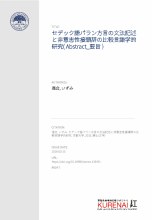4 0 0 0 OA アイヌ語の数詞再考 : 二十進法における下方算法から上方算法への切り替え
- 著者
- 落合 いずみ
- 出版者
- 日本北方言語学会
- 雑誌
- 北方言語研究 (ISSN:21857121)
- 巻号頁・発行日
- vol.11, pp.99-121, 2021-03-20
This paper reconstructs the vigesimal system and the numerals based on that system in Post-Proto-Ainu by comparing three dialects of Ainu: the Hokkaido dialect, the Sakhalin dialect, and the Kuril dialect. In the Ainu vigesimal system, multiples of 20 are indicated by hot, the word for “20,” whose proto form is reconstructed as *gOt. This paper analyzes the structures of the numerals between adjacent multiples of 20, such as the numerals from 21 to 39, from 41 to 59, and from 61 to 79. In the vigesimal system, each interval comprises 19 units. This paper proposes that the former nine units and the latter ten units show different structures. The units in the interval (e.g., 21 to 39) can either be expressed by the lower multiple of 20 (i.e., 20) or the higher multiple of 20 (i.e., 40). Expressing the units by using the lower multiple of 20 is called undercounting (or additive counting); expressing the units by using the higher multiple of 20 is called overcounting. This paper claims that the former 9 units (e.g., 21 to 29) use undercounting, whereas the latter 10 units (e.g., 30 to 39) use overcounting. The undercounted numeral 21 is expressed as “1 more than 20.” The overcounted numeral 30 is expressed as “10 goes toward 40,” and 31 as “11 goes toward 40.” In previous studies, the latter ten units have been explained by different counting methods. The odd multiples of ten (e.g., 30, 50, and 70) have been explained by subtraction (i.e., 40−10, 60−10, and 80−10, respectively). The following numerals (e.g., 31, 51, and 71) have been explained by a further addition of digits (i.e., 40−10+1, 60−10+1, and 80−10+1, respectively). This paper treats these ten units in a uniform manner by proposing an overcounting numeral system for them.
3 0 0 0 OA アタヤル語における「朝」の語源について
- 著者
- 落合 いずみ
- 出版者
- 東京外国語大学アジア・アフリカ言語文化研究所
- 雑誌
- アジア・アフリカ言語文化研究 (ISSN:03872807)
- 巻号頁・発行日
- vol.2023, no.106, pp.5-18, 2023-09-30 (Released:2023-09-30)
This study discusses the manner in which Atayal (Atayalic subgroup, Austronesian language family) underwent a semantic shift in time expressions such as “a little while ago,” “now, today,” and “morning, tomorrow.” In relation to this, the forms for “yesterday,” “a little while ago,” and “later” are also discussed. In Proto-Austronesian, the meanings of “morning” and “tomorrow” are inseparable, and this form is reconstructed as *dama. In earlier Atayal, sasan meant both “morning” and “tomorrow.” The Atayal form, sasan, “morning, tomorrow,” does not reflect *dama. This study examines the origin of sasan in Seediq (Atayalic subgroup), a language closely related to Atayal. In Seediq, the form for “now, today” is saða, and it later became saya. The ð dates back to the Proto-Atayalic *j; thus, a tentative form in Proto-Atayalic can be reconstructed as *saja, meaning “now, today.” The Proto-Atayalic *j is reflected as g, r, or s in Atayal, so *saja can be reflected as saga, sara, or sasa. The last form, sasa, may be related to sasan “morning, tomorrow.” It is likely that -an was attached, a suffix indicating time or space, resulting in sasa-an. Then, one of the a’s was deleted from the consecutive vowels, becoming sasan. Somehow, its meaning shifted from “now, today” to “morning, tomorrow.” This study proposes that this semantic shift was driven by another semantic shift relating to a Proto-Atayalic form, *sawni, which means “a little while ago.” This word extended its meaning to include “today in the morning” and then further extended to refer to “today”; it probably also referred to “now.” As sawni became “now, today,” sasan, the original word for “now, today,” shifted its meaning to “morning, tomorrow.”
2 0 0 0 OA セデック語パラン方言の文法記述と非意志性接頭辞の比較言語学的研究
- 著者
- 落合 いずみ
- 出版者
- 京都大学 (Kyoto University)
- 巻号頁・発行日
- 2016-03-23
新制・課程博士
2 0 0 0 IR セデック語パラン方言の文法記述と非意志性接頭辞の比較言語学的研究
- 著者
- 落合 いずみ Ochiai Izumi オチアイ イズミ
- 出版者
- 京都大学
- 巻号頁・発行日
- 2016
1 0 0 0 OA ブヌン語タキバカ方言のアクセントについて
- 著者
- 落合 いずみ
- 出版者
- 国立大学法人 琉球大学島嶼地域科学研究所
- 雑誌
- 島嶼地域科学 (ISSN:2435757X)
- 巻号頁・発行日
- vol.4, pp.33-45, 2023-06-30 (Released:2023-06-30)
ブヌン語イスブクン(Isbukun)方言は次末音節にアクセントを置く語が多く(次末型),タキトゥドゥ(Takituduh)方言などは語末音節にアクセントを置く語が多い(語末型)。これらブヌン語方言におけるアクセント位置は,Huang[2008]により最適性理論の枠組みにおいて制約の優先順序を交替することにより最適な出力候補を導くことによって説明されている。本稿は次末型に属するタキバカ(Takibakha)方言を対象にし,最適性理論に頼らずとも,モーラと音節,そして二重母音の関わりからブヌン語方言のアクセントが導けることを述べる。次末型では,次末モーラを含む音節にアクセントが置かれるのであり,母音連続ai, ia, au, ua, ui, iu が生じる場合は母音連続が語末に生じるか非語末に生じるか,母音連続が二重母音に変化するかどうかの違いによってアクセントに差異が出る。非語末の母音連続ai とau は二重母音と見なされ,非語末の二重母音ia とua は音位転換の後に二重母音に変わり,さらにe とo に変化する。母音連続iu とui は二重母音化しない。
